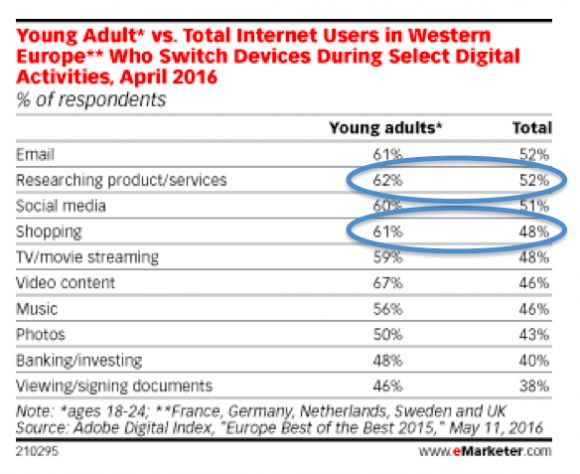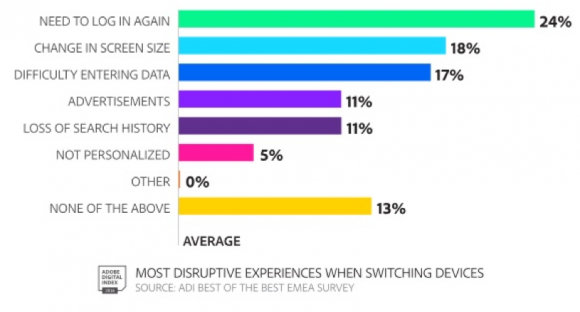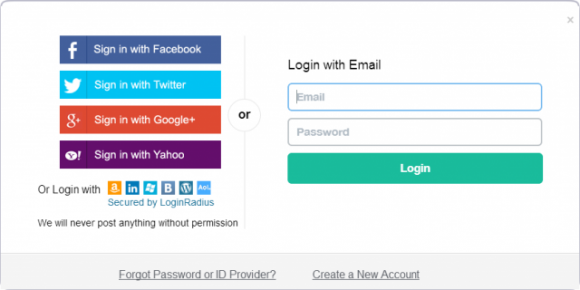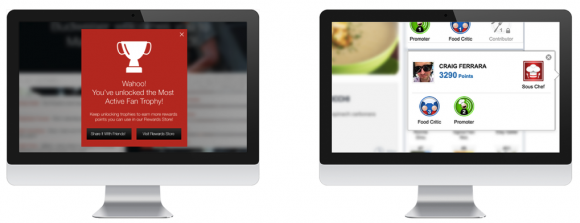Social login has imposed itself as a must-have for several years now, facilitating the website registration process for users. A new category of stakeholders has surfaced in its wake called Customer Identity and Access Management (CIAM) solutions.

They act as go-between for websites and social networks by taking over the implementation towards the main social login suppliers (Facebook, Gmail, Twitter, LinkedIn…) and offer to centralize customer repository.
In the current environment of customer data segmentation through various channels (web, mobile, social, e-mailing, offline) and various services (IT, marketing, sales), the aim is to put the customer at the core of the company.
Furthermore, by providing a link between social media and websites CIAM solutions are the cornerstone you can rely on to implement a digital customer centric omni-channel strategy and to offer a personalized customer experience through every channel.
SOCIAL LOGIN, A BUSINESS WEAPON
Brands and retailers shouldn’t lose sales because of registration restrictions or identification problems. Yet the classic registration process on e-commerce websites are tedious work for most users. They have to wait until they receive the confirmation email which sometimes takes a long time to be delivered or goes to spam. According to Adobe Digital Index’ latest study1 the majority of users – first and foremost Millennials (or Generation Y), perform their digital activities through several devices.
Thus, 61% of those 18-24 state they switch device for online shopping and 62% for products/services search.

According to that same study the login procedure is the first obstacle to an effortless cross-device experience for 24% of people, far ahead of facing problems with the size of the screens or difficulties to enter data.

SOCIAL LOGIN TO THE RESCUE
In case you have doubts about how a social login operates, here below is an excerpt:
- The user clicks on one of the social login tabs installed on the website;
- A request for authentication is sent to the chosen social network using a protocol for identification;
- The network confirms the existence of an account for this user and gives him access to the website.

SIMPLICITY & IMMEDIACY
A social login enables optimum user experience during the registration and identification procedure. Well-received by users a social login increases the conversion rate of landing pages and e-commerce websites.
Online vendor ASOS was one of the first e-commerce website to use a social login in 2015 to replace the guest checkout on its order validation page2.
The user can log on to a platform with just one click, making him ready to purchase a product or making an engaging interaction such as asking a question, leaving a review…
A BETTER KNOWLEDGE REGARDING CUSTOMERS
Some users are reluctant to give out personal information online and enter false data in questionnaires. In France 44% of people give incorrect information3 to protect their identity.
Yet 31% of people say that they frequently leave a website if they have difficulties to find their log in information4 and 77% respond that a social login is a good solution5 that should be available on every website. We feel reassured by this statement. Regarding landing pages it is clearly conceded that a social login increases conversion.
The benefit of social login is the transmission of the user’s personal data (first-party data) during the registration process. These data potentially represent all the information the user has given to the social network on its profile page (sex, age, marital status, children…) but also his likes and hobbies gathered from his timeline on the social network. Such information is reliable as social media profiles are read by family members, friends or colleagues, thus updated by the user.
A RELATIONSHIP OF TRUST
By imposing new identification standards a social login gives users a simple and reliable solution to register and supply personal data.
But beware: in return, users require complete transparency regarding the use of their data. We are talking here about protecting their privacy and personal data. Users must receive clear information on how their data is handled and when appropriate, how their data is given to third parties.
In a « give and take » approach it is necessary to give users flexibility for the management of their identity by making available data control systems, as well as opt-ins/opt-outs allowing them to choose which data is transmitted, at any given time.
This is exactly what CIAM solutions are providing.
RELYING ON CIAM FOR SOCIAL LOGIN AND IDENTITY MANAGEMENT
HAND OVER THE TECHNICAL COMPETENCY
Brands don’t often possess the historical expertise in the field of account creation, and implementing and keeping a system of your own is expensive even in outsourcing developments. Identity management becomes a problem as soon as the number of visitors increase.
Identity management is a task that requires means and competencies. It is necessary to have technical teams interested in OpenID and OAuth protocols.
By supporting the implementation of logins to Social ID suppliers, CIAM solutions ensure service continuity in case a social network wants to update one of these implementations.
They also ensure performance in dealing with a large volume of identities.
CIAM solutions meet high standards to ensure data privacy.This means by standards, for example the ISO/IEC 27001. An example of proposed procedure is the automatic deletion of an account if the associated social account is identified as suspicious. This is to ensure the privacy of the user’s sensitive data.
RESPECT REGULATORY REQUIREMENTS
By taking on the regulatory requirements of the various countries in terms of data privacy compliance, CIAM solutions make identities easier to manage for companies which have to meet their legal obligations. This is one of the arguments stated by Nutrica from the Danone Group, which uses Gigya to facilitate its customer identity management6. Please note that Gigya offers to choose countries for data locations.
PROPOSE A COMPREHENSIVE SOCIAL IDS’ OFFER
Given that social login might be differently popular according to regions, it is advisable for internationally-oriented companies to adjust to their audience’s location. Similarly for the BtoB-oriented companies, choosing the social network LinkedIn will be a very good call. Thanks to CIAM solutions, companies can benefit from a wide range of social media that allow them to better target their customers.
THE OTHER BENEFITS OF THE CIAM OFFER
CIAM solutions propose of course the ability to associate a classic existing account to a user name from a social network, thus keeping his records on the website. But it is also possible to log on to several social networks to offer social sharing on several networks simultaneously.
Single Sign On (SSO) – the substantial technology of social login, allows brands offering content through several websites to their customer – for instance the main website and mini acquisition websites, to ask for login details just once and to keep the user authentication on all the company’s websites. This mechanism greatly makes the data collection easier regarding the user journey through the various websites.
CIAM solutions have also planned everything to boost social interactions while reading content on the site.
Share, comment, grading and evaluating system, live chat, newsfeed, gamification by awarding trophies, loyalty points and discounts management, digital currency….So many ways to invite customers to commit to the brand. CIAM solutions simplify the implementation of a gamification solution.

For instance, Gigya includes a complete native solution to add gamification on websites, whereas Janrain and LoginRadius propose to integrate with Badgeville, a leading expert in this area.
IMPLEMENT A « CUSTOMER CENTRIC » STRATEGY VIA WEBSITES AND SOCIAL MEDIA

Users interact with online services made available to them by companies, in varied ways (web browser, mobile browser, native app…).
They become demanding and have low tolerance for a bad user experience. Therefore they expect a deeper relationship with companies, with first and foremost a unified experience between the various channels.
This relationship must not be intrusive. Users wait until they are able to check how brands collect, store, use and share their data.
PERSONALIZE USER EXPERIENCE ON WEBSITES
CIAM solutions enable companies to have a precise knowledge of its customers as soon as they first visit their websites. In order to gain such knowledge, they will need to convince users to log on and interact by providing value-added information in a « give and take » dialogue.
Users find an increasing interest in giving out personal information because platforms provide them with services and personalized experience in exchange. Of course companies must be transparent regarding such data use.
In this spirit, Progressive Profiling is a functionality provided by CIAM solutions allowing companies to collect progressively the user’s profile. The user is offered the ability to share some information at an appropriate time (viewing a product description, writing a review, sharing specific content, buying a product). With Progressive Profiling companies can seize vital information which will help them better understand where their potential customers are in their purchasing cycle:
- Are they only gathering information ?
- Are they at the evaluation stage by comparing one offer with another ?
- Are they already ready to buy but looking at prices ?
Asking a question during the key stages of the buying cycle helps companies to better understand if the offer or the implemented content mechanism meet their visitors’ needs.
Progressive Profiling is a good practice. It increases the conversion rate while reducing the size of registration forms. It also tends to reduce the sales cycle.
Detailed customer knowledge also enables companies to undertake customer experience personalization through the customization of interface and provided information.
PERSONALIZE USER EXPERIENCE ON SOCIAL MEDIA
By combining social login with a retargeting solution – for instance Facebook Custom Audiences and Facebook Interests Targeting, it is possible to provide a personalized user experience on social media.
Targeting registered users, regular users or those who have a profile similar to existing customers, is notably possible.
By segmenting the audience by personal interests and commercial reasons, these tools enable to go where the audience is without sending a unique message, and also allows to target niche markets.
The aim is also to promote upsell and cross-selling thanks to the use of customers’ feedback regarding purchases that have been made.
PUT THE CUSTOMER AT THE CORE OF THE COMPANY
The effectiveness of Inbound Marketing techniques is now well-established. To gain loyal customers companies need to motivate them with value-added content while feeding and cultivating their trust.
By providing a 360° vision of the user, CIAM solutions enable to better understand his actions on various channels and his underlying needs. This will help to build a long-term relationship with him.
CIAM is making the link between the Marketing department and business owners from specialized business lines by avoiding silos and by feeding analytics to help the business. For instance, it helps to deliver reports built up with demographic and behavioral data as well as generated income (purchase, clicked ads).
INTEGRATION THROUGH MARKETING AUTOMATION AND DATA MANAGEMENT PLATFORM (DMP) SOLUTIONS
Unlike CIAM which is designed to conversion, retention and commitment, Marketing Automation tools and DMP solutions mainly aim at gaining new customers.
As a reminder, DMP solutions enable to improve users’ first-party data by crossing them with partner data, anonymous third-party data and open data (weather, road traffic…) to generate segments. These segments will then be analyzed to optimize the marketing method and media strategy (paid SEO, banner display or retargeting).
CIAM SOLUTIONS DO OPTIMIZE A DMP ROI
Aggregating social data with behavioral data retrieved from browsing websites enables to have a more precise and complete view of users. Such solution also allows to maintain a user profiles repository waiting to be used, in synergy with DMP data.
AVOID STATIC PROFILES
A DMP is not designed to maintain a user data repository. It needs to be integrated and synchronized with the building block which will be managing this repository and therefore collect first-party data. CIAM solutions, by processing unstructured data from user profiles (« likes », path, etc.,…), will prevent inadequate static data.
ENSURE TRANSPARENCY WITH USERS
A social login allows to obtain the consent of users to use their data while giving them the opportunity to raise objections. DMP solutions don’t natively have this management mechanism made for authorizations. Developing such management method with associated authorization forms, is complicated and as we previously mentioned, not complying with the user’s privacy protection is not wise as users will quickly feel disrespected.
FLEXIBLE & UPGRADEABLE
By strengthening a unique view for users through various platforms and channels, CIAM solutions enable companies to be ready to interconnect with future third-party systems. For example the Gigya, Janrain and LoginRadius platforms already provide the ability to interconnect with many Marketing Automation app, CRM, DMP, advertising platforms…
HOW TO CHOOSE WHICH CIAM TO USE ?
DEFINE BUSINESS GOALS
Defining business goals is prerequisite to be making the right choices. Business challenges will guide you through finding the best solution.
SELECTION CRITERIA
- Customer data security – ease of use by customers. They must quickly adapt to the solution or they will leave.
- Performance and adaptability: gain momentum during events, parties…You need to make sure to choose a platform which will adapt to the conditions of use in order to ensure an optimal experience for users.
- Interoperability with sources of data (web, mobile, APIs) and apps from IS which need to continue to manage customer data
- Possibly the constraint of physical location of customer data.
CONCLUSION
Customer Identity and Access Management solutions are valuable allies for companies achieving their digitalization. They benefit from an architecture allowing them to better understand their customers and to implement a close relationship with them through optimized user experience.
The end of data silos also enables a more efficient collaboration between marketing and specialized business lines, which frees up more time for teams to fully dedicate their work to process improvement.
- Study “Europes Best of the Best 2015” conducted in 5 European countries (France, Germany, UK, Netherlands and Sweden). The study combines analytical data and a user survey.. Read the study. ↩
- For more on this topic “Q&A With the Expert: What ASOS’ New Social Sign-in Option Means for Ecommerce” by Tiffany Holland. ↩
- According to [the 2015 ACSEL-CDC indicator (in french)]. ↩
- According to Blue Research study published in 2012. ↩
- According to [a WebHostingBuzz study published in 2013]. ↩
- For more on this subject: «Nutricia-Danone Integrates Digital Commerce with Gigya’s Customer Identity Management Platform» on Gigya’s website. ↩





